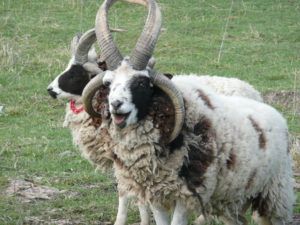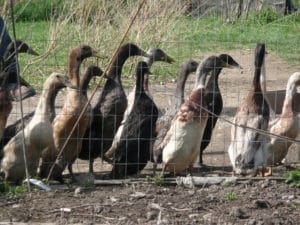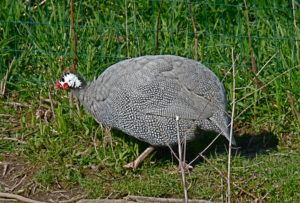Heritage Breeds: Ort’s Barnyard Menagerie
Sheep with four horns, ducks with red fleshy heads, and pigs that look like cows? This isn’t a scene from ‘Through the Looking Glass’, but a description of the barnyard menagerie found on the Ort Family Farm near Bradford, NY, home to multi-species of Heritage livestock and poultry.
Roger Ort and his wife Maria, along with their four children, have been farming in New York State since 1999 after moving to the area from central Pennsylvania. “We came here with the intent to live off the land and provide for our children,” says Maria.

Jacob Sheep, a hearty heritage breed, derives its name from the old testament refernce. Males can have up to 6 horns, and females up to 4. Photo by Lindsay Debach
“And to live a more peaceful life than the rat race that we had lived in before.” Today, the curiosities seen around their yard comprise their heritage breed farm, where they raise cattle, pigs, sheep, goats, rabbits and poultry for meat and eggs.
Heritage livestock and poultry breeds are by definition endangered. According to the American Livestock Breeds Conservancy (ALBC), heritage livestock breeds are “traditional species of livestock: asses, cattle, goats, horses, pigs, rabbits, and sheep”. The breeds must also meet certain population criteria before being classified in the Critical (less than 2,000 globally for livestock), Threatened, Watch, Recovering or Study categories.
Heritage breeds are simply farm animals that were left behind as agriculture in the United States moved in a direction of becoming highly specialized, favoring only one or two genetic species for uniformity and efficiency. Farm animals not favored by commerical agriculture became increasingly rare, to the point of being at risk of extinction. The dairy industry holds a prime example: as Holstein cow populations grew, lesser-used breeds of dairy cows (i.e. Guernseys, Ayrshires) diminished in number. As a result of similar specialization, many breeds of poultry, cattle, sheep, and hogs face critically low numbers and extinction.
Maria Ort and her family started with heritage cattle, and then added on heritage pigs. Two rabbits given to their kids for 4-H started their multi-species rabbitry, where the Orts now raise Crème D’argent (a breed developed in France), Lop and Chinchilla rabbit breeds. Little by little, their heritage collection grew. ”We’ve always been interested in the unusual,” jokes Maria.
One trip around the farm proves this to be true. Grazing on open pasture are their multi-horned Jacob Sheep. A breed that derives its name from its reference in the Old Testament, the males can have up to 6 horns, while the females can have up to four. Next door, wallowing happily in mud, are their two Hereford hogs (with babies on the way), a breed developed in the 1920’s to have the same red and white coloring as the sturdy Hereford Cattle.

Indian runner ducks, standing completely upright, are a heritage egg-producing breed. Photo by Lindsay Debach
Reddish brown and white Belted Galloway cattle roam in pastures behind the farm house. With thick, curly coats, these belted beef animals are remniscent of black and white buffalo and sought after for their lean meat.
Wandering in the Ort’s poultry pen are hawk-billed Russian Orlof chickens (originating in Iran), Malays (standing over two feet tall), in addition to Delaware and Americana breeds (all in the Watch or Endangered category). Free-roaming around the yard are speckled guinea fowl and muscovy ducks with a crimson, fleshy head. (The latter, though not endangered, offer meat that is 98% lean). Indian Runner ducks (a breed that stands completely upright) quack in a line around their yard, while the protective American Buff geese honk away intruders as they guard their nests.
Though the farmyard may look like a random collection of circus oddities, the Orts chose each species very carefully. Limited infrastructure and a harsh winter climate makes it necessary for them to keep animals that can thrive outdoors.
“It was a matter of finding something that’s really self-sufficient because we have the terrible winds and it’s cold.” notes Maria. “We wanted to have things that could survive, that are adapted to conditions we have.”
There is also an issue of limited space, so animals that can survive in smaller pastures were important too. “We chose [Jacob Sheep] because they’re a smaller breed for the space that we have” explains Maria. “They’re not as demanding on pasture. They still produce about a 35-40 lb. carcass at 9 months.” The Jacob sheep is also resilient in the damp spring climate of upstate New York, resistant to foot rot and other ailments experience by less heartier breeds. “A normal sheep in this wet a pasture would have all kinds of foot problems,” says Roger, “but they’re not having anything!”
Finding the right breeds for their colorful barnyard was not easy. “We’ve had a lot of trial and error” stresses Maria. Before establishing their herd of Belted Galloways the Orts mistakenly purchased Dutch-belted cattle, a black and white short-haired dairy breed. “They stood there and shivered the whole winter,” laughs Roger. “We realized that we got the wrong belted cow…it was a learning curve!”
The Orts also experimented with breeds of Turkeys, experiencing several losses of commercial Turkey varieties before switching to a heritage breed. “They [white turkeys] tend to get sick real easy,” says Roger. “When we switched over to the Bourbon reds we didn’t have nearly the losses like we did with the white ones.” Roger observes that because of the mistakes they made initially with commercial animals, he and Maria were better equipped to raise the more costly and endangered, heritage breeds. “Sometimes it does help to do the commercial ones at first. You don’t really want to be making a lot of mistakes with a breed that only has 100 left.”

The Guinea fowl, native to Africa, freely wander around the Ort farm yard. They eat a variety of insects and aid in controlling parasites and ticks. Photo by Lindsay Debach
The fact that the Orts are stewards of several endangered species of livestock and poultry encourages them through the difficult times on the farm. “Each one is a link to the whole chain and when they’re gone, they’re gone,” notes Roger who observes that each heritage breed has distinctive traits important for the welfare of its species. “Let’s say there’s a disease,” he explains “and one of them could have exhibited disease resistance, but it’s gone. You can never breed it back in.”
In addition to the unique traits possessed by the heritage breeds, the Orts also like them as a way of promoting bio-diversity. “We don’t just raise cows, we don’t just raise pigs,” Maria explains. “We recognize that all the different types of livestock can work together and that they’re all important parts of a farm, rather than having one crop.” By raising multiple species and breeds, the Orts enable these animals to work together with the land to encourage a healthy, functioning ecosystem.
The variety of their crops and animals has helped the Orts to create a niche local market for selling their products. “We pretty much sell everything we raise,” Maria said .“We’re sold out of beef for a year. We’re sold out of pork ‘til next year. The lambs are 60% committed already.” Able to provide everything from beef to rabbit to heirloom vegetables, they have developed a loyal customer base selling out of their farm store and at regional meat shows.
Moving forward, the Orts remain committed to providing naturally-raised heritage meats and eggs to their customers. They are also working toward their goal of one day becoming a teaching farm. “We think it would be a neat thing to teach kids about heritage breeds that they don’t [normally] see,” says Roger. He would also like to demonstrate how on their bio-diverse farm the animals and the land work together to create a healthy, diverse ecosystem. “The sheep will eat down further than the cows, and then the turkey’s will clean up all the manure from both of them…That’s just all part of what we want to teach in the future. Look, this is what you can grow. This is how it all works together,” adds Maria.
Throughout their years on this out-of-the ordinary farm, the Ort family has experienced its challenges. But in spite of the hardships, they move forward with an important goal in mind. “We feel our calling is to feed people,” reflects Maria. “We try to keep that vision in whatever we endeavor to do in our lives.”
For more information on the Ort Family Farm, including purchase information of heritage meats, visit their listing on Local Harvest.
To learn more about Heritage Breeds, visit the American Livestock Breeds Conservancy.

